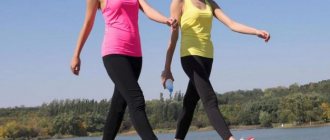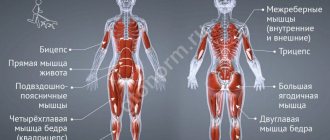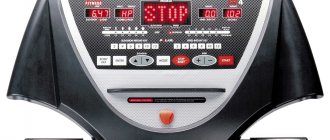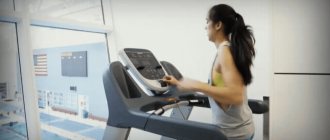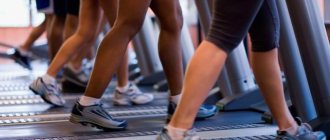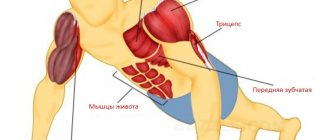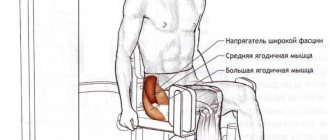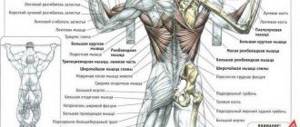The benefits of treadmills
Nothing beats jogging in a pine forest or along the seashore, but in urban environments a treadmill is a great substitute for real running.
What are the benefits of a treadmill?
- regular cardio exercises train the heart and strengthen blood vessels, increasing the overall endurance of the body;
- running accelerates fat burning, helping you lose weight without gaining a mountain of bulky muscles;
- the calf muscles, thighs and buttocks take on beautiful, smooth shapes;
- metabolism improves, and now you can indulge in dessert at lunch;
- Running provides excellent health and well-being.
While exercising on the treadmill, you will notice that the blush does not leave your cheeks, your sleep has improved, and minor difficulties no longer drive you crazy. And this is a small part of the benefits that a treadmill gives a person.
Don't have a treadmill at home yet? — the technique of running in place will help. Start training immediately!
And you can quench your thirst with carrot juice.
Who is the exercise recommended for?
There is a lot of debate online about what exactly is best to include in your training program: walking or running on a treadmill. It should be said that walking is no less effective in terms of developing endurance and getting rid of excess fat, and is certainly healthier. The fact is that the treadmill is designed in such a way that we do not run along it - we catch up with it. This places unwanted stress on the knee joints and over time can lead to meniscus or hamstring injuries.
So, here are a few categories of people for whom this exercise is ideal:
- Walking on a treadmill is recommended for those people who have knee problems. It will help maintain physical fitness and avoid worsening injuries;
- This is a great exercise for those who are just starting to exercise. By walking on a treadmill from the first days of training, you will gain excellent endurance and save your knees;
- Interval walking on a treadmill is perfect for athletes suffering from hypertension. It allows us to work at a comfortable heart rate (115-130 beats per minute), while running increases the heart rate to 140-170 beats per minute, which is too much for a hypertensive cardiovascular system;
- Also, measured walking on a treadmill is good for those people who have only recently quit smoking and started leading a healthy lifestyle, and their respiratory system is not yet ready for serious strength or cardio exercise. After a month of regular walking on a treadmill, their shortness of breath will decrease or completely disappear, the functioning of the cardiovascular system will normalize, their lungs will get used to delivering more oxygen to the muscle cells, and only after that can they begin full-fledged exercise in the gym.
On the subject: Block for neck muscles
What does a treadmill do?
For those who dream of starting to run, but cannot muster the strength, a treadmill will be a great start. It will prepare the human body for stress and help you fall in love with running. By exercising regularly, you will become so accustomed to training that you will no longer be able to go a day without jogging.
A treadmill gives an opportunity to exercise for everyone who cannot exercise outside or go to the gym: it is easy to combine a run on the machine with watching a TV series and communicating with family.
The treadmill is a great way to warm up before a strength workout. After a run, your metabolism will increase, and strength training will be most effective. In addition, jogging will be an excellent final element of a long workout and will help relax the muscles after exercises with dumbbells.
Treadmill: what muscles work?
While jogging on the treadmill, all muscle groups are strengthened, although running is not a strength exercise, but a cardio exercise . While running, our whole body tenses up. It uses the strength of the entire muscular frame, giving stress to the back, neck and even the muscles in the arms.
Of course, the calf muscles and other leg muscles, such as the gluteal muscles, work the most.
By the way, modern models of treadmills are equipped with an adjustable angle of inclination, by changing which you can use different muscles: give more load to the buttocks or train the front surface of the thigh.
Learn about the principle of operation of a pedometer - it will help in your studies.
I suggest you remember children's sports equipment for jumping.
Let's do https://dolgieleta.com/sportivnaya-zhizn/domashniy-sport/fitnes/uroki-fitnesa-v-domashnikh-usloviyakh.html home fitness exercises.
How to properly exercise on a treadmill?
Unsystematic, aimless activities will not bring any positive effect and may even harm the body. To get the maximum benefit and results from having a treadmill at home, it is important to know how to exercise on it correctly.
- You can't start classes without warming up. Be sure to do a small set of simple exercises to awaken your muscles. Stretching the entire body is also important: careful stretching will help prevent muscle damage.
- You can exercise only if you feel well: if you feel tired or heavy in your back, it is better to replace jogging with yoga for today.
- For proper jogging, you need the right clothes: buy special running shoes with shock-absorbing soles that reduce the load on the foot, wear comfortable breeches or running pants. For women, the use of a supportive bra is recommended.
- It is controversial whether or not to drink water during class. Doctors say that the body should not be dehydrated, but fluid during running puts extra strain on the heart. If you're thirsty, be sure to drink - just take very small, slow sips.
Rules for effective walking
To get the most out of this type of cardio workout, follow these simple rules:
- Always start your workouts with a thorough warm-up. Particular attention should be paid to the knees and ankle joints, and the quadriceps and calf muscles should also be well warmed up.
- Drink enough water during exercise. By drinking at least a liter of still mineral water in small sips, you will protect yourself from disturbances in the layer balance in the body.
- Don't change the length of your steps. Try to take steps of the same length throughout the entire workout - this will allow you to maintain a uniform walking pace and increase the effectiveness of your cardio exercise;
- Finish your workout with a cool-down. When you are already exhausted and cannot walk at a brisk pace, do another 10-20 minutes of walking at a leisurely pace. Due to the increase in heart rate when walking quickly, during a cool-down, fat burning and metabolic processes in your body will not weaken.
- Decide on the optimal workout duration. Scientists believe that lipolysis processes during physical activity begin to occur at full capacity only after 35-40 minutes, but at the same time, too long cardio (more than 80 minutes) can lead to the breakdown of muscle tissue. Therefore, the optimal duration of walking on a treadmill is about 60 minutes.
How long should you run?
The duration of the lesson depends on various factors: the goal you are pursuing, the general endurance of the body, readiness for stress, and especially on the heart rate.
It is the pulse that is the main indicator of how much you need to run. So, if your heart rate rises above 140 beats per minute, you need to temporarily pause the workout or slow down the pace.
A full workout on the treadmill should last on average 40 minutes . However, you don’t need to rush at top speed for the entire forty minutes. Intense exercise (at a heart rate of 120-140) can last no more than 10 minutes. The rest of the time you need to run at an average or slow pace.
To understand how much you need to run, it is best to develop your own training program or use systems recommended by experienced athletes.
Features of training
The key to success is constant practice. It is advisable to train three times a week. Please note that walking should not be too intense, especially in the first lessons. Do not overload the body, do not overstrain the muscles.
Monitor your heart rate during exercise. First, you should determine cardiac parameters in a normal state, and then during exercise. If the number of heart beats becomes too high, you should rest and restore your breathing. If you feel that your breathing is difficult, this means that you are overloading your body. Loads should be increased gradually.
Another condition for success is the correct execution method. You should walk at an average rhythm, that is, without straining.
There are several options for movements that can be performed by both beginners and experienced athletes.
- Standard step. During such movements, you should keep your body straight and imitate the movements of climbing stairs. By changing the pressure on the pedals, the pace of walking changes.
- Half-foot step. When performing such a walk, the body should be straight. Steps should be fast and small, all emphasis should be placed on the forefoot.
- Tough step. This type of gait involves a slight tilt of the body forward, the emphasis should be on the full foot, the pressure should be slow, but with little effort.
Treadmill workout program
Depending on the results you want, you can use different running programs. Each of them gives a different effect.
- If you don't have much time, but want to lose weight, so-called interval training . It only takes 8-10 minutes, during which two running speeds alternate: light, about 5 km/h, and intense, 7-10 km/h. Every minute or two you need to change your running speed. This method quickly fires up the metabolism and helps the body go into fat-melting mode.
- Endurance training involves a long 30-minute session, the running speed of which is distributed as follows: the first 10 minutes are a warm-up, during which the heart rate should not exceed 100 beats per minute, then 10 minutes of running at maximum speed, after which another 10 minutes jog slowly to restore your heart rate.
- The most effective training program that guarantees rapid fat burning is 40 minutes of continuous running at low speed . Stopping and taking breaks is not recommended, nor is trying to run faster. The main principle of this program is the body’s transition to using up its own fat reserves.
Thus, various training programs will help both improve endurance and speed up the process of losing weight.
Are you trying to lose weight?
Experts from around the world agree that it is walking that will help you (long, first leisurely (warm-up), then intense and, finally, “cool-down”). However, it is generally accepted that not eating for an hour and a half after walking on a treadmill and drinking enough water is the option that is most suitable for people trying to get rid of extra pounds.
Are you tired of blood pressure, heart rhythm disturbances?
It’s unlikely that you should immediately accept your friends’ offer to “run in the park in the morning.” Running develops your heart rate to 170-180 beats per minute. This is the key disadvantage of intense exercise: it can be harmful for a hypertensive person or a person with documented heart rhythm disturbances.
Are you a non-professional athlete?
Consequently, there is no talk of a muscle corset, as well as super-elastic ligaments, “hardened” joints and “rope vessels” through which a trained heart pumps blood. It's too early to run! It’s worth walking around to prepare your body for running.
Are you a diabetic, a smoker, or is your body mass index greater than 30?
Go. Just walk, not run on a treadmill. And you will never regret that you gave your body a feasible load.
Fast walking on a treadmill for weight loss!
Is this a myth or reality? Perhaps fast running is best for “fast” weight loss? No. The truth is that taking a step on a treadmill helps you lose weight no worse (and most importantly, safer) than a desperate attempt to sweat out 15-20 minutes of running (super-intensive) training. And that's why.
Fast walking on a treadmill
Walking on a treadmill specifically for the purpose of “losing weight!” should take place in the morning. And that's why. Catabolic processes predominate in the human body in the morning. In order to maintain a walking pace, the body, even in such a “gentle” (non-running) mode, requires a power source. And this source of nutrition becomes the fat located under the skin, which goes “into the furnace” in deeds, and not in words, if you train on an empty stomach.
Treadmill walking program
Only beginners may think that a treadmill walking program is a “somewhat depleted” training option. In fact, there are a great many variations of walking on a treadmill, and this deserves a separate paragraph of our article.
Interval training - we will specifically focus on walking on a treadmill, the benefits of which will be maximum. And the efficiency will be able to please in the shortest possible time both those who want to normalize their heart rate by lowering blood pressure, and those who gravitate toward basic weight loss.
What is "interval"? This is a continuous change of movement variations throughout the entire workout (walking fast, slow, downhill, without a slope). The human body is unique. He can adapt to anything. And this is where they don’t allow him to adapt to anything.
You should start with a “sturtle” walk at a speed of 4 km/h, and even if you want to “rush,” you need to maintain this slow pace for 10 minutes of walking without bending over. The next phase of training is key. It lasts about 30 minutes. And it is important to increase the inclination angle by 2 degrees every 5 minutes, gradually increasing the load. What about speed? Let it also be increased by only 1-2 km, to 5-6 km/h.
Simple calculations allow us to establish that at the highest point of walking on a treadmill, your inclination angle will have to be as much as 12 degrees. This is a lot. Having reached the peak, reduce the load by 2 degrees every one and a half to two minutes during the so-called “cool-down” phase. As a result, you must again “march” along a completely horizontal surface.
So, 50-60 minutes of interval training. After walking on the treadmill, to achieve maximum effect, do not eat for 1-1.5 hours.
"Mountain training" The difference between this training option is that after the first “warm-up” stage, which lasts about 10 minutes at a speed of 4-5 km/h, you immediately set a large inclination angle of 8-10 degrees. And you walk at a speed of 6 km/h for thirty minutes.
With such an inclination of the running belt, walking will never seem easy to you. The body receives sufficient stress to normalize weight, heart rate, blood pressure, but at the same time the pulse does not break through extreme levels, the risk of a heart attack, overtraining, muscle pain, and other negative consequences is minimal.
The training format will be appreciated not only by men, but also by women. Walking uphill strengthens and tightens the buttocks, creating relief in the calf muscles.
The “mountain training” ends with a cool-down phase, during which the incline is reduced to zero, and the movement continues at a “reset” speed of 4 km/h for the next 10 minutes.
Walking with weights . Over time, when it seems that walking has become “too easy,” you can, of course, run. But that would be a mistake. Even if your ultimate goal is to run and compete in half marathons and marathons, don't rush into running mode. It will be great to add weights.
You can pick up small dumbbells (0.5 kg or 1 kg), or you can attach special weights to your ankles and wrists, which will make walking more difficult, but at the same time increase the effectiveness of the workout.
This format (walking with weights) is suitable for those who have already mastered the treadmill or want to accelerate the achievement of results. Start with 0.5 kg weights. Increase, if you can, by half a kilogram every week.
Do not neglect three-phase training: first warm-up (10 minutes at a speed of 4 km/h), then the main mode - half an hour at 6 km/h (at first without an incline, then you can complicate the process by setting an incline of 4-6 degrees), and in the final - cool-down phase. Calm walking with weights on a horizontal surface.
What happens to the body after walking on a treadmill?
In order to answer this question, it is necessary to understand the specifics of the chosen training. What happens after walking on treadmills?
Already during the workout, fat burning processes are launched. As already noted, you lose weight most effectively if your heart rate is increased to 120-130 beats per minute. Attention! It is in the walking mode that visceral (subcutaneous) fat does not return (of course, if you do not start eating bread rolls at night).
Blood circulation improves. Walking (as opposed to an unreasonably abrupt “running start,” which in itself is stressful for the body) makes its health-improving contribution to the state of the cardiovascular system. Blood pressure is lower. And the pulse becomes lower after walking on a treadmill for 2-3 months. Extrasystoles and heart rhythm disturbances disappear.
You do not feel tired, but a surge of efficiency. Congratulations! You have managed to develop your body's endurance. This means that it’s not only about excellent physical fitness, but also about increasing business and production performance, which walking on a treadmill gives.
Will a treadmill help you lose weight?
Treadmill Spirit Esprit XT385 - cost around 47,000 rubles.
Most women buy a treadmill not to increase their endurance or strengthen their muscles, but to lose weight. And this is the right choice, because running has a great effect on the fat burning process .
In order for the fat burning process to start, you need to devote at least 20 minutes to training. You can exercise every day, supplementing jogging with proper nutrition and visiting the bathhouse.
When jogging, fat burning is particularly effective in the lower torso, thighs, buttocks, and stomach, but you will still notice results throughout the body: this is the benefit of cardio training.
You can lose weight on the treadmill:
A home treadmill is an excellent recipe for those who want to lose weight - aerobic exercise increases the heart rate, speeds up the metabolism and provokes increased weight loss.
However, it is important to distinguish which kilograms the body gets rid of: it is impossible to lose 1 kilogram of fat in a day, and large plummets are explained by the loss of excess water. To avoid dehydration, watch your drinking regime and do not stop exercising, and very soon the weight will shift.
How many calories can you burn?
Exercises on the treadmill are the leaders in the number of calories burned. So, in the process of fast walking, the treadmill can help you burn 300-400 calories per hour. If you want to get rid of more, you will have to sweat: running intensely for an hour will deprive you of 500, or even 700 calories .
Is it possible to pump up your legs on a machine?
Is it possible to increase muscle mass in the legs, is it possible to lose belly fat by working out on a treadmill, and what training options are most suitable for this? Let's look at three types of exercises on a treadmill and make a choice.
During interval training
Repeated alternation of two types of load - intense, with acceleration to the limit of capabilities, with running at an easy or medium pace at certain time intervals is called interval training.
On an electric trainer, you can set all the parameters of such a workout to suit yourself, and the track itself will not allow you to cheat and make your life easier. Such classes are really very effective for:
- for weight loss and fat burning (especially in the lower back and abdomen);
- heart and vascular training;
- increasing muscle strength and endurance;
- variety and change of impressions when running in one place.
But if our goal is to pump up our legs, this is not your option. In addition, you should remember: such training is not recommended for beginners; they require considerable physical preparation.
Training on an incline
This program is more suitable for those who do not strive to increase muscle mass in the legs, but, on the contrary, to dry legs, strength and clear relief. That is, ideally, these are the lower limbs of professional athletes. Beauty and lightness are obvious, but the only muscles that grow under such loads are the calf muscles , the rest of the leg muscles do not sway. The reason is that the calves belong to the class of slow fibers, requiring long loads at low intensity. A 40-minute jog three times a week can give you this result, and at the same time your abdominal shape will also improve.
Attention! The change in the position of the canvas can be expressed either in degrees or as a percentage. It's not the same thing. Interest must be calculated mathematically.
To properly use all the functions of the simulator, you must first familiarize yourself with how to use the simulator.
When combining running and weight training
But this is exactly our case . But you also need to combine strength training with treadmill running wisely. How to exercise in order to not only maintain your muscle mass, but also increase it?
Running until exhaustion after strength training will give the opposite result: having completely used up the carbohydrate energy reserve glycogen in the gym,
the body, with continued exercise, will begin to partially break down fat and muscle protein to produce energy - that is, dry out the muscles.
But if you, for example, run in the mornings as exercise on your simulator, and train with free weights three times a week in the evenings, this will ensure maximum muscle growth.
You will only spend glycogen, which can be replenished from session to session, and metabolism in the leg muscles loaded with such alternation will accelerate, which will contribute to the production of testosterone and muscle fiber growth hormone.
Don’t forget that regardless of the program you choose, you need to remember the 8 rules for effective exercise and be sure to follow safety precautions.
For an even better understanding, watch some videos:
Here is a slightly controversial, but no less interesting material:
Pros of treadmills
People like the treadmill because it helps them stay fit every day. It’s not so easy to force yourself to go outside: it’s either too wet and windy or too hot. A home track will allow you to get rid of all excuses and start regular exercise.
The advantages of treadmills are as follows:
- the ability to constantly run even in urban conditions: no need to look for a special park for jogging;
- comfort of a home environment: no need to go out into the street at dawn or be embarrassed by the looks of passers-by;
- the flat surface of the path will protect the feet from various injuries, unlike asphalt with holes;
- on the track you will not be able to brake sharply, which could harm your heart, and you will gradually reduce the pace;
- The treadmill is a universal means of maintaining health and endurance and can act as a separate full-fledged workout.
However, treadmills also have contraindications, which are important to consider before starting any exercise.
Feedback on using the treadmill
If you read the reviews of many fitness experts, there is little doubt that walking on a treadmill is one of the best exercises for weight loss of all. Professional athletes also agree with the experts and actively use this simulator to improve their own body and improve athletic performance.
Among the adherents of using a treadmill during cardio workouts is UFC champion Conor McGregor. In his opinion, this exercise, along with a bicycle and a rowing machine, allows you to develop endurance.
The result of such training speaks for itself: Conor is the most popular and highly paid mixed martial arts fighter. His fees grow with every fight, and his every fight with an opponent is not discussed on the Internet except by the lazy. Conor's physical attributes are also phenomenal. He has incredible endurance, strength and fighting qualities, while constantly maintaining a body fat level of less than 10%, although to do this he sometimes has to literally “die” on the treadmill.
Source
Contraindications for treadmill running
Despite their many benefits, treadmills are not for everyone . It is best to talk to a doctor who will answer your questions and help you create the right training program that will only bring benefits.
What are the contraindications to jogging on the track?
- diseases of the leg joints: arthritis, arthrosis, etc.;
- any disorders of the musculoskeletal system, especially osteochondrosis in any manifestations;
- cardiovascular diseases: VSD, high blood pressure, heart disease, etc.;
- any diseases of the respiratory system: asthma, pulmonary failure, bronchial diseases, etc.
In addition, doctors strongly recommend limiting or minimizing exercise during pregnancy and breastfeeding. However, a small load, doctors admit, will even be useful.
So, if you have no contraindications to running, you need to choose the treadmill that suits your needs and will give you the joy of regular physical activity.
Electric treadmills for home
In electric models, the belt under the runner’s feet rotates independently , under the influence of electric current, focusing on a given program. She will control the entire training process, making sure that the athlete does not deviate from the intended speed and runs for the required amount of time. A great find for those who need a trainer!
Also, electric tracks can be supplemented with other pleasant technical details: for example, monitoring the runner’s heart rate . Most models have the ability to turn on music, and sometimes there are more serious developments: for example, a safety sensor , which turns off the movement of the canvas when a problem occurs. This will help if the runner falters.
The disadvantages of electric tracks include, first of all, the price. A high-quality model, equipped with many additional gadgets, will cost the buyer a decent amount. Secondly, electric tracks are quite bulky.
If you want to purchase an inexpensive, small and lightweight model, focus on mechanical treadmills.
Mechanical treadmills for home
Most people begin their acquaintance with the world of treadmills with mechanical models. Of course: they are popular, affordable, and also compact .
However, often, after training for a week or two, newly-minted athletes give up racing. The reason is that a mechanical treadmill is a very specific exercise machine that will not appeal to everyone.
Unlike electric tracks, in which the belt is set in motion under the influence of current, in mechanical devices all the work falls on the runner's legs . This can be called both an advantage and a disadvantage of the equipment.
When running on a mechanical treadmill, your legs become more tired, and especially your calves. If the electric treadmill provides only cardio exercise, then the mechanical treadmill trains the calf muscles, as on a regular jog .
The mechanical track provides a natural run that is not determined by any program. The runner himself chooses the speed, rhythm, and running time. He works out the way he feels comfortable. Unfortunately, on such a track it is easy to overtrain or, on the contrary, allow yourself to be lazy.
Thus, if you need to imitate natural running conditions as much as possible and feel how your legs work, your choice is a mechanical treadmill. But if you are a beginner who needs a general aerobic workout, or you have problem joints, stick to the electrified belt.
Walking with an incline
Walking on an inclined plane differs from regular walking on a horizontal surface or from jogging - two types of fitness that are considered the most effective and physiological for strengthening the cardiovascular system and fighting excess weight.
The biomechanics of walking on an incline are more complex than on a horizontal surface, similar to stepping lunges or movements when pushing a support. The participation of the hands is minimal; they work rather as movement stabilizers and bear the main load. The maximum load when moving with an incline falls on the muscles of the thighs, calf muscles and buttocks.
Benefits of Inclined Walking
Walking at an incline allows you to significantly diversify your workout, whether walking in the fresh air or on a machine in the gym. Monotony is tiring, adding a new element, even something as simple as changing the angle of inclination, changes the workout.
Walking on an incline has a higher intensity; it burns more calories per unit of time, all other things being equal: speed of movement and length of the distance, which is a big advantage when training for weight loss.
When walking with an incline, a power element is connected. Walking on an upward slope requires more effort from different muscle groups in the legs, as well as ligaments, tendons and joints. The strength component can significantly strengthen the muscles involved in walking.
Walking at an incline can be a solution if running is contraindicated, and the loads obtained as a result of regular walking are not enough to achieve the desired result. The incline increases the anaerobic load, and if walking is done on a treadmill, this load can be calculated.
Moving up an inclined plane requires greater body coordination than regular walking, thereby training endurance and coordination.
Incline walking on a treadmill
Walking at an incline on rough terrain in natural conditions and walking on a treadmill are two very different things.
When walking at an incline on rough terrain, the angle of inclination constantly changes, ascents are replaced by descents, and the body is forced to constantly adapt to the changes.
Such variability of loads, on the one hand, allows you to diversify the training and train coordination of movements, on the other hand, makes it impossible to purposefully work on certain muscle groups.
Attention!
The treadmill does not have these disadvantages. It is easy to set a certain angle of inclination on it, gradually increase it, achieving a progressive increase in the load.
Some tracks have the function of automatic modes, in which you can simulate movement on hills, when climbs alternate with descents at a certain angle, or a constant “uphill” climb, and after reaching the “peak” the simulator simulates a descent.
Walking with an incline for weight loss
This type of walking allows you to burn more calories, which means you can lose excess weight faster. A 70-kilogram person walking for half an hour at an average speed (6 kph) burns approximately 130 kilocalories. If you walk at a constant incline of five percent at the same speed, then in the same half hour of walking you can already burn 230 kilocalories.
Lifting at an angle of 10 percent further increases calorie burn. A half-hour walk by a 70-kilogram walker will require an expenditure of 330 kilocalories.
What should be the incline for weight loss?
In this matter, not everything is so clear. It would seem that the higher the incline, the more calories are burned. However, with a certain combination of speed and incline, cardio training turns into strength training, and cardio is important for losing excess weight. Overloads when walking on an inclined plane for weight loss are undesirable. This only reduces efficiency.
A minimum angle of 1-3 percent allows you to compensate for wind resistance, which is not present in the gym, unlike walking in the fresh air. This angle simulates a slight forward lean of the body, which always appears when walking at medium or higher speeds.
An angle of 5 percent increases energy consumption, 8 percent makes it as efficient as possible. Lifting to a greater angle forces the muscles to work harder.
For effective weight loss, not only the angle of inclination when walking is important, but also its speed and duration.
Rules for walking at an angle for weight loss
Clothes that should not restrict movement and shoes that should have firm soles are important, even if the workout takes place in the gym on a treadmill.
First you need to set the slope to 2 percent. This will create additional resistance, as when walking in the fresh air with a light wind. Minimum speed – 3-4 km/hour.
Ten minutes of such walking will allow you to feel the rhythm and also warm up your muscles, which will not only avoid injuries (unwarmed muscles are often injured when the load increases), but will also prepare you for increased loads.
Warm-up is also important because it increases blood circulation.
Then you should gradually increase the incline by 1-2 percent every five minutes, gradually increasing the speed.
When the speed reaches 6 km/h, the inclination angle should be 8 percent. For the next 20-25 minutes you should walk in this mode, this is the maximum load. Then gradually reduce the incline to 5 percent at the same speed. As the angle of inclination decreases, the load gradually decreases.
As your level of fitness increases, the duration of movement under an incline in maximum mode should be increased to 30-40 minutes. For weight loss, it is important that the duration of peak exercise is at least 30 minutes.
Important!
If your heart rate (HR) does not reach optimal values for weight loss, you should increase the inclination angle of the treadmill to 10 degrees. However, such a load is permissible only with a certain degree of training.
A heart rate of 140 beats per minute is considered optimal for weight loss. This is an average value that does not take into account many factors: age, initial weight, gender and health status. There are several methods for calculating the optimal heart rate for weight loss. You can use either one to calculate your peak heart rate.
On the subject: Running after 50 years for women - harm or benefit?
Dangers of Stooped Walking
Walking is the safest form of fitness, and walking at an incline is no exception. This method of losing weight can become risky if basic safety rules are not followed.
In particular, when wearing uncomfortable shoes, there is a risk of injuring the arch of the foot.
If you force things and train at peak heart rates without prior preparation, you can overload the heart.
For young, healthy people, this can lead to shortness of breath and a feeling of overtraining. For older people and people with health problems, this risks more serious problems, including heart attack and stroke.
Therefore, it is extremely important to increase the load gradually.
Source: https://www.woman-lives.ru/health/hodba-s-naklonom.html
Compact treadmill
Not every home can accommodate a treadmill. Massive, bulky models take up a lot of space and sometimes interfere with normal movement around the room. What to do if you want to play sports and at the same time maintain home space?
An excellent solution is to purchase a compact treadmill. It differs from others only in its size . Among mechanical models it is much easier to find compact tracks than among electric ones, because they have fewer additional devices.
Compact treadmills can be purchased from almost every manufacturer: usually these are devices whose running belt is 10-15 centimeters narrower than usual (35 centimeters versus the usual 50). This option is quite suitable for a medium-sized man or a slender girl.
However, you should not skimp on the length of the track: even if it seems that 80-90 centimeters in length may be enough for a full run, this is not so. Running on a short track turns out to be very unnatural and in the future threatens joint problems. The ideal length of the canvas is 110 centimeters.
Benefits of the simulator
Stepper helps:
- stabilize weight, as it helps burn excess fat deposits;
- strengthen the muscles of the buttocks and legs;
- train your back and abs;
- adjust your figure;
- improve metabolic processes;
- develop coordination.
Regular workouts on a mini-exercise machine for your home will provide you with a slim and toned body. Such training can be prescribed as therapeutic. This happens in the case of rehabilitation after the main course of treatment of injury or in case of degenerative diseases of the spine and limbs.
The main advantage of such a device is its ease of operation. The mini-trainer is inexpensive and does not take up much space.
Folding Treadmill for Home
If you don’t have room in your apartment even for a compact walkway, take a closer look at folding options. This track can be easily hidden under the bed or thrown into the trunk, and if necessary, unfolded and used for its intended purpose.
Unfortunately, such tracks are rarely found on sale, and their price is quite high for the characteristics offered. Folding tracks are also most often mechanical. They also produce electrical devices - however, with a minimum number of additional functions.
The choice of treadmills today is huge - electric and mechanical, folding and compact. You can find models for quick weight loss and for strengthening muscles. The treadmill will become your daily ally in your active life.
Whatever path you choose for yourself, regular training will ensure you feel great, have a great mood and always have a blooming appearance.
